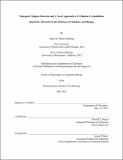Damaged Collagen Detection and A Novel Approach to 1,3-Dipolar Cycloaddition Reactivity: Research at the Interface of Chemistry and Biology
Author(s)
Dones Monroig, Jesús M.
DownloadThesis PDF (39.37Mb)
Additional downloads
Advisor
Ronald T. Raines
Terms of use
Metadata
Show full item recordAbstract
Part I
Chapter 1. Collagen Mimetic Peptides as a Selective Binder for Damaged Collagen. “Collagen diseases” were first introduced by Klemperer and coworkers in the 1950s. This type of disease can cause fibrinoid degeneration or changes in the collagen fibers that denature the collagen triple helix. Collagen mimetic peptides (CMPs), variants that are monomeric in solution but have high ability to anneal with damaged collagen, are a growing tool in the biomedical field for the detection and treatment of collagen-related diseases. This chapter provides a review of recent developments in the field of damaged collagen targeting for studying collagen-related diseases and injuries.
Chapter 2. Optimization of interstrand interactions enables burn detection with a collagen-mimetic peptide. In this chapter, through a computational screen, we identify (flpHypGly)7 as an optimal monomeric CMP for heterotrimer formation. We find that (flpHypGly)7 forms stable triple helices with (ProProGly)7 but not with itself. The nonnatural amino acid HflpOH, which is (2S,4S)-4-fluoroproline, is not toxic to human fibroblasts or keratinocytes. Conjugation of (flpHypGly)7 to a fluorescent dye enables the facile detection of burned collagenous tissue with high specificity. The ubiquity of collagen and the prevalence of injuries and diseases that disrupt endogenous collagen suggests widespread utility for this approach.
Chapter 3. A Cyclic Peptide Mimetic of Damaged Collagen. In this chapter, a duplex of CMPs was envisioned as a macromolecular mimic for damaged collagen. The duplex was synthesized on a solid support from the amino groups of a lysine residue and by using olefin metathesis to link the N termini. The resulting cyclic peptide, which is a monomer in solution, binds to CMPs to form a triple helix. Among these, CMPs that are engineered to avoid the formation of homotrimers but preorganized to adopt the conformation of a collagen strand exhibit enhanced association. Thus, this cyclic peptide enables the assessment of CMPs for utility in annealing to damaged collagen. Such CMPs have potential use in the diagnosis and treatment of fibrotic diseases and wounds.
Chapter 4. Optical imaging of collagen fiber damage to assess thermally injured human skin. In this chapter, we present two complementary candidate methods for visualization of collagen structure in three dimensions. Second harmonic generation imaging offers a label-free, high-resolution method to identify intact collagen. Simultaneously, a fluorophore-tagged collagen-mimetic peptide can detect damaged collagen. Together, these methods enable the characterization of collagen damage in human skin biopsies from burn patients, as well as ex vivo thermally injured human skin samples. These combined methods could enhance the understanding of the role of collagen in human wound healing after thermal injury and potentially assist in clinical decision-making.
Chapter 5: Hox genes maintain critical roles in the adult skeleton. Recently, it has been demonstrated that Hox expression continues from embryonic stages through postnatal and adult stages exclusively in a skeletal stem cell population. However, whether Hox genes continue to function after development has not been rigorously investigated. In this chapter we discuss Hox11 critical roles in skeletal homeostasis of the forelimb zeugopod (radius and ulna). We generated a Hoxd11 conditional allele and induced genetic deletion at adult stages. Together, our studies show that Hox11 genes continuously function in the adult skeleton in a region-specific manner by regulating differentiation of Hox-expressing skeletal stem cells into the osteolineage.
Part II
Chapter 1. Acceleration of 1,3-Dipolar Cycloadditions by Integration of Strain and Electronic-Tuning. The 1,3-dipolar cycloaddition between azides and alkynes is enabling new means to probe and control biological processes. A major challenge is to achieve high reaction rates with stable reagents. The optimization of alkynyl reagents has relied on two strategies: increasing strain and tuning electronics. In this chapter we report on the integration of these strategies through both computational and experimental analysis. A computational analysis suggested that a CH→N aryl substitution in dibenzocyclooctyne (DIBO) could be beneficial. In transition states, the nitrogen of 2-azabenzo-benzocyclooctyne (ABC) engages in an n→π* interaction with the C=O of α-azidoacetamides and forms a hydrogen bond with the N–H of α-diazoacetamides. These interactions act cooperatively with electronic activation of the strained π-bond to increase reactivity. Both ABC and DIBO are accessible in three steps by the alkylidene carbene-mediated ring expansion of commercial cycloheptanones. Our findings enhance the accessibility and utility of 1,3-dipolar cycloadditions and encourage further innovation.
Date issued
2021-06Department
Massachusetts Institute of Technology. Department of ChemistryPublisher
Massachusetts Institute of Technology